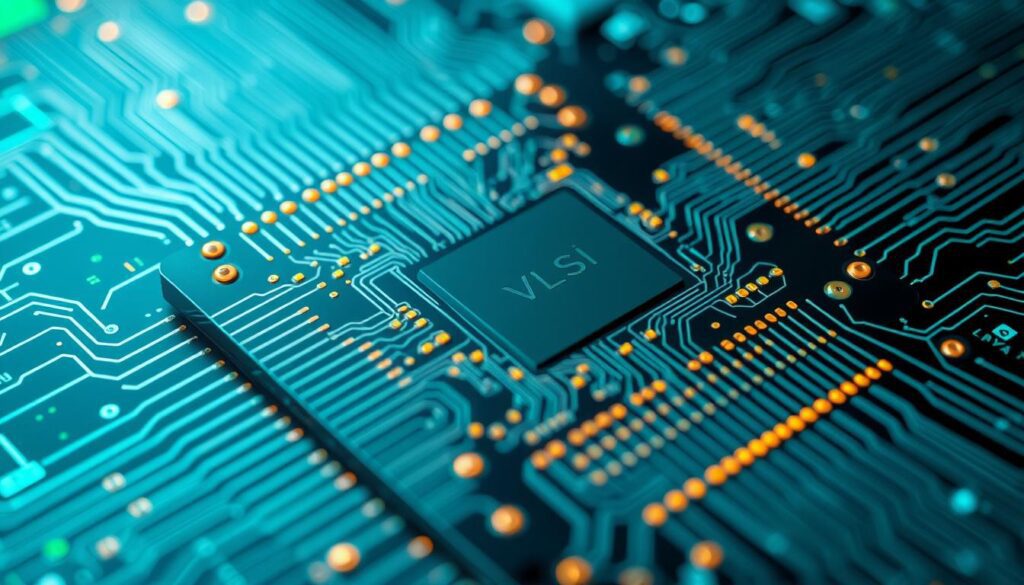In the dynamic landscape of VLSI design, the pursuit of energy-efficient and high-performance semiconductor devices has become a paramount concern. As the demand for compact, battery-powered devices and energy-conscious data centers continues to rise, we must navigate the intricate challenges associated with physical design for low-power devices. Power consumption, timing closure, design constraints, testability, and verification are just a few of the critical aspects that require careful consideration in order to achieve optimal power efficiency while maintaining reliability and performance.
The power consumption of each component in a VLSI design is directly influenced by a multitude of factors, including activity, frequency, transition time, capacitive load, voltage, leakage current, and peak current. Companies across the industry have placed a strong emphasis on developing low-power design techniques, such as clock gating, multi-voltage domains, power gating, and advanced methods like zero-pin retention flops and dynamic voltage scaling. These strategies aim to enhance battery life in portable devices, reduce system costs, and achieve substantial power savings in server farms.
As we delve deeper into the intricacies of physical design for low-power devices, we must address the challenges posed by the ever-evolving semiconductor landscape. From the doubling of transistors per unit area with each new process technology to the significant impact of IR drop on delay variation, the VLSI industry must navigate an increasingly complex design environment. Additionally, the increasing design rule count and the need for effective DRC/DFM engines highlight the importance of comprehensive design optimization strategies.
Table of Contents
Understanding Power Consumption Fundamentals
In the world of VLSI (Very Large-Scale Integration) circuits, power consumption is a critical factor that physical design engineers must address. The major consumers of power in these circuits are dynamic power, static power, and short-circuit power. Understanding the underlying mechanisms and optimizing these power components is essential for achieving low-power VLSI designs.
Dynamic Power and Switching Activities
Dynamic power is a result of the switching activities in the circuit. It is a function of the switching frequency, supply voltage, and capacitance. As the circuit components switch between different logic states, they charge and discharge the parasitic capacitances, leading to power dissipation. Optimizing the dynamic power requires careful consideration of the circuit’s switching characteristics and the design of efficient logic gates and interconnects.
Static Power and Leakage Current
Static power, on the other hand, is caused by the leakage currents in transistors when they are not switching. As transistor sizes continue to scale down, the leakage current becomes a significant contributor to the overall power consumption. Addressing static power requires advanced circuit design techniques, such as threshold voltage scaling, power gating, and the use of low-leakage transistors.
Short-Circuit Power Components
Short-circuit power arises from the direct current paths during logic state transitions. When a logic gate switches, there is a brief period where both the pull-up and pull-down networks are conducting, creating a short-circuit path and dissipating power. Minimizing short-circuit power requires careful timing and gate-level optimization to ensure efficient logic transitions.
By understanding these power consumption fundamentals, physical design engineers can employ various power optimization techniques at the design stage to achieve low-power VLSI circuits. These techniques may include clock gating, power gating, voltage scaling, and advanced circuit design methodologies.
| Test | Duty Cycle | PWM Ratio | Current Load | Battery Runtime |
|---|---|---|---|---|
| 1 | 4% | 10 | 0.1mA | 1000 hours |
| 2 | 58% | 150 | 1.85mA | 54 hours |
| 3 | 100% | 255 | 3.16mA | 31 hours |
Critical Power Optimization Techniques
Designing energy-efficient devices requires a deep understanding of various power optimization techniques. Let’s explore some of the critical methods that can help us achieve significant power savings in our circuits.
Clock Gating
Clock gating is an effective technique that reduces dynamic power consumption by disabling clock signals to inactive circuit blocks. By selectively stopping the clock, we can prevent unnecessary switching activities and minimize the overall power draw of the system.
Multi-VDD Design
Multi-VDD design allows different parts of the chip to operate at varying supply voltages. By assigning appropriate voltage levels to different functional blocks based on their performance requirements, we can optimize power consumption without compromising overall system functionality.
Power Gating
Power gating is a method that uses sleep transistors to switch off the power supply to idle blocks, effectively reducing static power leakage. By strategically applying power gating, we can achieve significant energy savings in our designs.
Placement Optimization
Efficient placement and routing of circuit elements can minimize capacitance and resistance within interconnects, leading to a reduction in both dynamic and static power consumption. Careful placement optimization can contribute to the overall power efficiency of the design.
These power optimization techniques, when combined with other strategies like dynamic voltage and frequency scaling (DVFS), low-power standard cell libraries, and clock tree synthesis, can help us create highly energy-efficient devices that meet the growing demand for low-power electronics.
| Technique | Description | Power Savings |
|---|---|---|
| Clock Gating | Disabling clock signals to inactive circuit blocks | Up to 30% reduction in dynamic power |
| Multi-VDD Design | Assigning different voltage levels to functional blocks | Up to 40% reduction in total power |
| Power Gating | Turning off power supply to idle blocks | Up to 90% reduction in static power |
| Placement Optimization | Efficient placement and routing of circuit elements | Up to 20% reduction in dynamic and static power |

PD for Low Power Devices: Key Design Considerations
Designing power-efficient devices requires careful consideration of several key factors, including multi-voltage domain implementation, clock tree synthesis strategies, and power gating methodologies. These techniques play a crucial role in reducing power consumption and ensuring optimal performance for low-power applications.
Multi-Voltage Domain Implementation
Implementing multiple voltage domains allows critical blocks to operate at higher voltages for performance, while less critical components can run at lower voltages to improve energy efficiency. This approach helps balance the trade-off between power consumption and device performance, ensuring that the most important functions maintain high speeds while the overall power budget is optimized.
Clock Tree Synthesis Strategies
Strategies for clock tree synthesis in low-power designs focus on reducing clock skew and enhancing efficiency. By carefully planning the clock distribution network and implementing techniques like clock gating, designers can significantly reduce dynamic power consumption associated with the clock tree.
Power Gating Methodologies
Power gating methodologies involve the use of sleep transistors to cut off power to idle blocks, effectively reducing static power consumption. This technique allows the system to selectively power down unused components, leading to substantial energy savings without compromising overall functionality.
In addition to these key considerations, designers should also account for early power estimation, hierarchical design approaches, leakage management techniques, and the use of power intent specification formats like UPF and CPF to ensure comprehensive power optimization for low-power devices.
| Design Consideration | Benefit |
|---|---|
| Multi-Voltage Domains | Balances performance and power consumption by allowing critical blocks to run at higher voltages while less critical components operate at lower voltages. |
| Clock Tree Synthesis | Reduces clock skew and enhances efficiency, leading to lower dynamic power consumption. |
| Power Gating | Cuts off power to idle blocks, effectively reducing static power consumption and improving energy efficiency. |

Physical Design Constraints and Trade-offs
Designing low-power VLSI devices requires careful consideration of physical design constraints and the trade-offs involved. As we strive to optimize area utilization, we must balance it with performance factors, such as managing signal delays. Shrinking circuit sizes can reduce power consumption, but it may also increase signal delay. Advanced algorithms and tools for placement and routing optimization help us achieve better area utilization while minimizing signal delay.
Additionally, we must address the trade-offs between power efficiency and computational performance. Design complexity, especially in large chips with multiple power domains, presents another challenge. Thermal management is crucial, as power consumption directly affects heat generation and dissipation within the chip. Effective thermal management strategies are essential to ensure the overall reliability and performance of low-power VLSI devices.
| Design Constraint | Optimization Objective | Trade-off Consideration |
|---|---|---|
| Area utilization | Maximize circuit density | Potential increase in signal delay |
| Signal delay | Minimize propagation delay | Potential impact on power consumption |
| Performance | Maximize computational speed | Balance with power efficiency requirements |
| Thermal management | Ensure optimal heat dissipation | Impact of power consumption on heat generation |
By carefully navigating these physical design constraints and trade-offs, we can develop low-power VLSI devices that deliver the desired performance while maintaining energy efficiency and thermal stability.
Advanced Power Management Solutions
In the pursuit of efficient power management for low-power devices, we have access to a range of advanced techniques that can significantly optimize energy usage. These include dynamic voltage and frequency scaling (DVFS), thermal management strategies, and leakage power control methods.
Dynamic Voltage and Frequency Scaling
DVFS is a powerful approach that allows us to dynamically adjust the processor’s voltage and frequency based on the workload demands. By scaling these parameters in real-time, we can achieve substantial energy savings without compromising performance. This technique is particularly beneficial for mobile and IoT applications, where power efficiency is a critical factor.
Thermal Management Techniques
Effective thermal management is essential for maintaining optimal device performance and reliability. We can employ strategies such as strategic component placement, the use of heat sinks, and the implementation of thermal vias to efficiently dissipate heat. These techniques ensure that our low-power designs can operate within safe temperature ranges, ultimately enhancing their longevity and reliability.
Leakage Power Control Methods
Minimizing leakage power is another crucial aspect of advanced power management solutions. Techniques like body biasing, transistor sizing, and gate oxide optimization can help us effectively control and reduce leakage current. By addressing this challenge, we can further optimize the energy efficiency of our low-power devices, making them ideal for mobile, IoT, automotive, and data center applications.
Source Links
- What is Low Power Design? – Techniques, Methodology & Tools | Synopsys
- Design challenges in physical design
- Microsoft PowerPoint – lecture1
- What is a low power design?
- Power Consumption Analysis of Bluetooth Low Energy Commercial Products and Their Implications for IoT Applications
- Power Optimization Techniques in Digital IC Design – 4
- How to Reduce Power Consumption in a Circuit
- Power Isolation
- How to Design Low Power Devices | Simplexity Product Development
- IOT – Internet of Things Low Power Design Rules – OnElectronTech
- Physical design (electronics)
- Physical Design: Methodologies and Developments
- Plain text
- PMIC Click featuring an advanced Power Management Integrated Circuit (PMIC) for rechargeable applications

